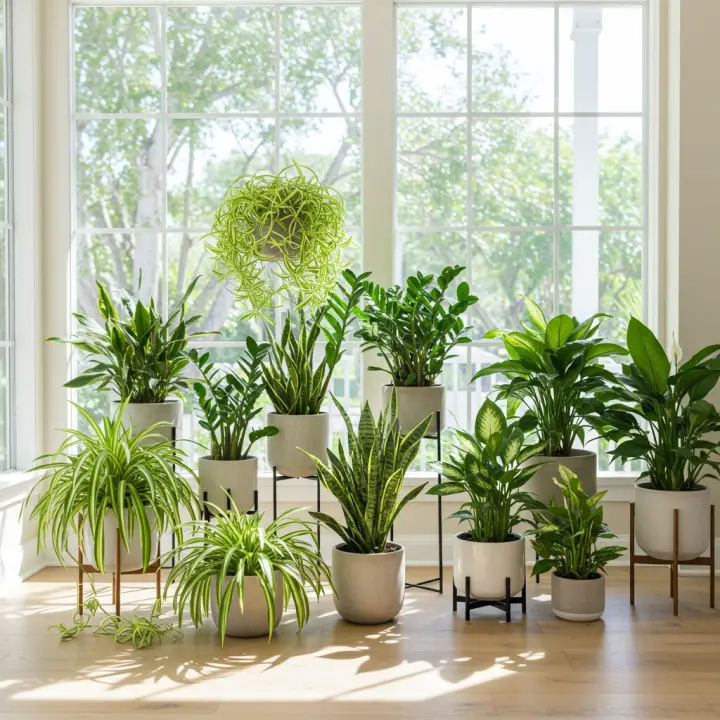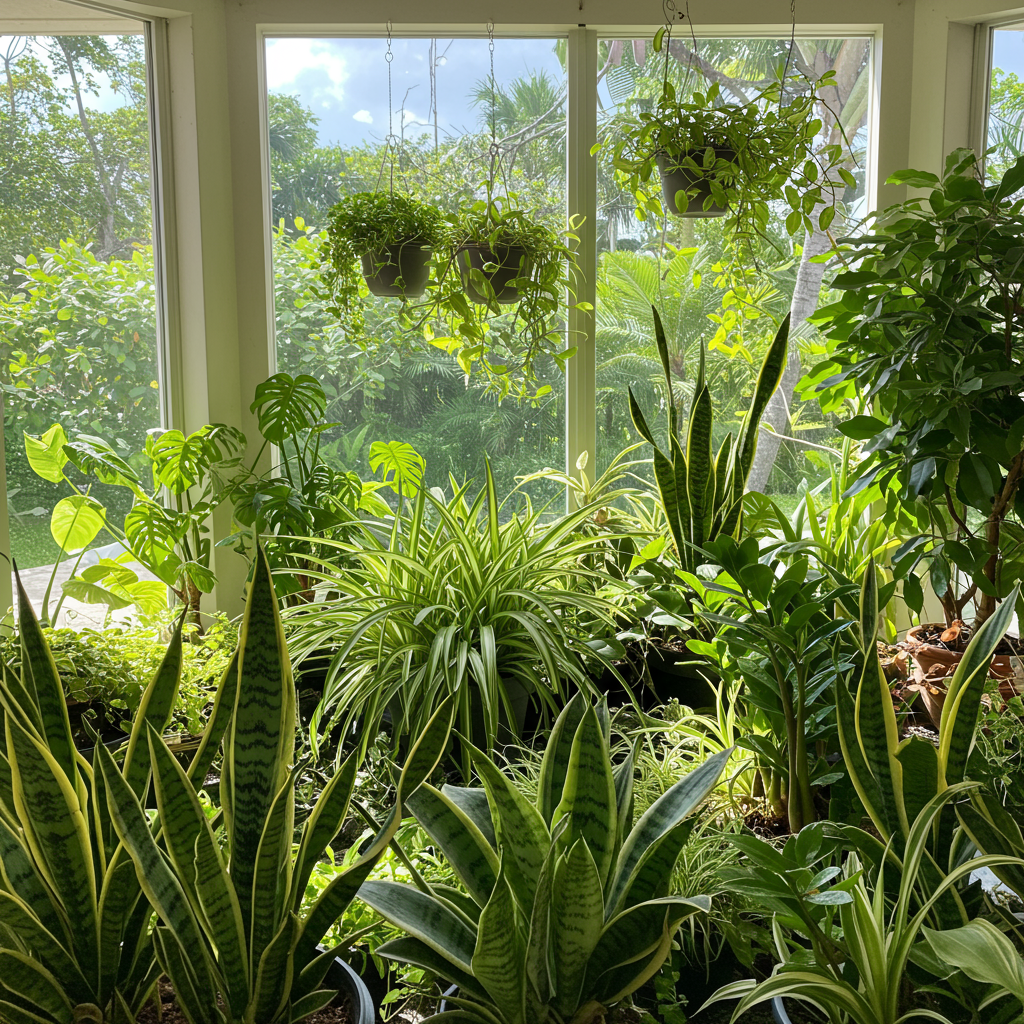Discover how indoor plants aren’t just beautiful decor, but powerful natural air purifiers, especially beneficial for Florida homes. Learn which species thrive in Florida’s climate, effectively removing toxins and improving your indoor air quality, making your home a healthier sanctuary.

Why Florida Homes Need Air-Purifying Indoor Plants
Florida’s beautiful climate comes with its own set of indoor air quality challenges. High humidity can lead to mold and mildew, while common household items, building materials, and even outdoor pollutants seeping in contribute to a cocktail of Volatile Organic Compounds (VOCs) like formaldehyde, benzene, and trichloroethylene. These silent invaders can cause allergies, respiratory issues, and other health concerns.
Fortunately, nature offers an elegant solution: indoor plants. These green allies do more than just add aesthetic appeal; they actively work to clean the air you breathe, transforming your Florida home into a healthier, fresher haven.
How Plants Purify Your Air: Nature’s HVAC System
The concept of plants purifying air isn’t new; NASA’s Clean Air Study in the late 1980s famously highlighted their efficacy. But how exactly do they do it?
Absorption Through Leaves: Plants absorb airborne toxins through microscopic pores (stomata) on their leaves. Once inside, these compounds are converted into nutrients or safely stored.
Root System Power: The soil and root systems play a crucial role. Microorganisms in the soil break down pollutants, adding another layer of purification.
Transpiration: As plants release moisture into the air through transpiration, they create a natural air circulation effect, pulling contaminated air towards their leaves and roots.
Humidity Boost: For drier Florida homes, plants naturally increase indoor humidity, which can alleviate dry skin, respiratory discomfort, and even help reduce airborne viruses.
Top Indoor Plants: The Best Air Purifiers for Florida Homes
Not all plants are created equal when it comes to air purification, and some are better suited to Florida’s unique indoor conditions. Here’s a list of highly effective and relatively easy-to-care-for options that thrive in Florida’s typical indoor environments:
1. Snake Plant (Sansevieria trifasciata)
Why it’s great for Florida: Incredibly resilient, low-maintenance, and tolerant of various light conditions. It’s unique in that it releases oxygen at night, making it perfect for bedrooms.
What it removes: Benzene, formaldehyde, trichloroethylene, xylene, toluene.
Care Tip: Prefers drier soil; water sparingly, especially in winter.
2. Spider Plant (Chlorophytum comosum)
Why it’s great for Florida: Easy to grow, produces “spiderettes” (baby plants) for propagation, and is non-toxic to pets. It adapts well to different light levels.
What it removes: Formaldehyde, xylene, toluene, carbon monoxide.
Care Tip: Keep soil consistently moist but not waterlogged.
3. Peace Lily (Spathiphyllum)
Why it’s great for Florida: Beautiful white flowers and dark green foliage, thrives in humid conditions typical of Florida. It even lets you know when it needs water by drooping its leaves.
What it removes: Ammonia, benzene, formaldehyde, trichloroethylene, xylene.
Caution: Toxic to pets and humans if ingested. Keep out of reach.
4. Golden Pothos (Epipremnum aureum)
Why it’s great for Florida: Extremely robust and adaptable, tolerates neglect, and can be grown in hanging baskets or on shelves. Its vibrant leaves add a tropical touch.
What it removes: Formaldehyde, benzene, carbon monoxide, xylene, toluene.
Care Tip: Water when the top inch of soil feels dry. Tolerates low light but thrives in bright, indirect light.
5. Areca Palm (Dypsis lutescens)
Why it’s great for Florida: A larger plant that adds significant greenery and can act as a natural humidifier. Its feathery fronds evoke the Florida outdoor landscape.
What it removes: Formaldehyde, xylene, toluene, carbon monoxide.
Care Tip: Likes bright, indirect light and consistently moist soil. Benefits from higher humidity.
6. Boston Fern (Nephrolepis exaltata ‘Bostoniensis’)
Why it’s great for Florida: Loves humidity, making it a perfect fit for many Florida homes. Its lush, vibrant green fronds are excellent at purifying.
What it removes: Formaldehyde, xylene, toluene.
Care Tip: Requires consistently moist soil and high humidity. Mist regularly if your home is dry.
7. Aloe Vera (Aloe barbadensis miller)
Why it’s great for Florida: Not just a source of soothing gel; this succulent is great at filtering the air and is very low maintenance.
What it removes: Formaldehyde, benzene.
Care Tip: Thrives in bright, indirect light and prefers dry conditions between watering.
Tips for Maximizing Air Purification with Indoor Plants
To get the most out of your green air purifiers in Florida, consider these strategies:
Quantity Matters: The more plants you have, the more effective they’ll be. NASA recommended 15-18 plants for an 1,800-square-foot home.
Strategic Placement: Place plants in rooms where you spend the most time, such as bedrooms and living areas. Consider rooms with new furniture or electronics, which often off-gas VOCs.
Proper Lighting: Ensure your plants get the right amount of light. Healthy plants are better purifiers. Most air-purifying plants prefer bright, indirect light.
Regular Cleaning: Dust can accumulate on leaves, hindering a plant’s ability to absorb pollutants. Gently wipe leaves with a damp cloth every few weeks.
Adequate Humidity: Florida’s natural humidity is a boon for many of these plants. Just ensure good air circulation to prevent fungal issues.
* Avoid Overwatering: This is a common mistake. Overwatering can lead to root rot and attract pests, making your plant less effective.
FAQs About Indoor Air-Purifying Plants in Florida
Q1: How many indoor plants do I need to purify the air effectively in my Florida home?
A: While estimates vary, a general guideline is one 8-10 inch potted plant per 100 square feet of living space. For significant purification, consider 2-3 plants per average-sized room.
Q2: Are air-purifying plants safe for pets and children in Florida homes?
A: Many popular air-purifying plants like Peace Lilies and Pothos are toxic if ingested. Always research a plant’s toxicity before bringing it into a home with pets or young children. Safe options include Spider Plants, Areca Palms, and Boston Ferns.
Q3: Can indoor plants really remove all the toxins from my air?
A: While incredibly effective, plants are a natural solution and work best as part of an overall strategy for good indoor air quality. They significantly reduce common toxins but shouldn’t be your sole line of defense, especially against severe air quality issues. Combining them with good ventilation and regular cleaning is ideal.
Q4: Do larger plants purify more air than smaller ones?
A: Generally, yes. Larger plants with more foliage have a greater surface area for absorbing toxins and more extensive root systems to process them. They also release more oxygen.
Q5: What’s the best way to keep my air-purifying plants healthy in Florida’s climate?
A: Most air-purifying plants prefer consistent, indirect light and well-draining soil. Pay attention to watering – check the soil moisture before watering. Florida’s humidity is often a benefit, but ensure good air circulation to prevent mold.
Conclusion: Embrace the Green Revolution in Your Florida Home
Bringing indoor plants into your Florida home is a simple yet profoundly effective way to enhance your indoor air quality naturally. Far more than just decorative accents, these living air purifiers actively work to remove harmful toxins, boost oxygen levels, and create a more serene and healthy living environment.
By choosing the right species and providing them with basic care, you can transform your home into a verdant oasis that not only looks beautiful but also contributes to your well-being. So, go ahead – embrace the power of nature and let these green guardians help you breathe easier in your Florida sanctuary.

